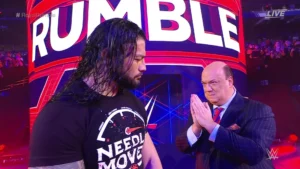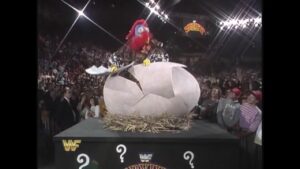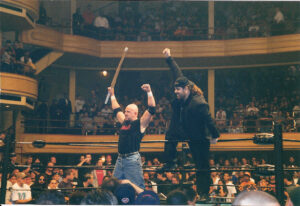When Kurt Angle retired from in-ring competition in WWE in 2019, he did so with no shortage of pro wrestling accolades. Inducted into the WWE Hall of Fame in 2017 (and both the TNA/IMPACT – 2013, and Wrestling Observer Newsletter – 2004, hall of fames before that), Angle ended his career with 21 championships, 13 of which were world championships across major companies including WWE, TNA, and in Japan. He was WWE’s 10th Triple Crown Champion and fifth Grand Slam Champion, both prestigious honors. Angle was the first wrestler in history to win both the TNA and WWE triple crowns, an honor he now shares with AJ Styles. But it is Angle, not Styles, who has the distinction of winning both WWE’s King of the Ring (2000) and TNA’s King of the Mountain (2007 and 2009). He is the only wrestler to do so. Most impressively, however, is that Angle is also the only wrestler to have won the WWE Championship, WWE World Heavyweight Championship, WCW Championship, TNA World Heavyweight Championship, and IWGP Heavyweight Championship. His longevity and talent undeniably make him one of the best and most well-rounded men to ever step foot in a ring, whether four-sided or six.
But before all of those accolades, before he was just a Sexy Kurt who drove a milk truck and preached the three Is of Intensity, Integrity, and Intelligence, Angle was something much greater. Kurt Angle was (and is) an Olympic hero, whose storied 1996 journey to the gold in freestyle wrestling, is one of trial, tribulation, and ultimately triumph. Oh, it’s true, it’s damn true.
A Collegiate Star
In pro wrestling, it’s not rare to see amateur and collegiate wrestlers make the transition from the mat to the ring. Tons have done so over the years and while not as prevalent as before, Greco-roman or freestyle wrestling backgrounds and experience still remain a pipeline for those to begin their pro wrestling careers. While Kurt Angle was not the first, nor will he be the last such college wrestler to move to WWE, he is arguably the best. Having taken up wrestling as a young boy, Angle quickly excelled at the sport, winning several amateur-level tournaments including both the Pennsylvania State Wrestling Championship and USA Junior Freestyle Championship in 1987, during his senior year of high school. Before that, Angle reached the state tournament in his sophomore year before finishing in third his junior year. In 1988, Angle picked up perhaps the biggest win of his career to date, winning the USA International Federation of Associated Wrestling Styles Junior World Freestyle Championship. This victory, coupled with what Angle would achieve down the line, makes him one of just four individuals to complete amateur wrestling’s grand slam (junior nationals, NCAA, world championships, and Olympics).
Fully focused on his wrestling career, Kurt Angle enrolled in Clarion University of Pennsylvania, not far from his home of Pittsburgh. Upon entering Clarion, Angle joined the school’s amateur wrestling team hoping to get one step closer to a goal he had set for himself when he was just seven years old: to be an Olympic gold medalist. At Clarion, Angle shined, medaling in three consecutive NCAA Division I Wrestling Championships and being named a three-time All American. By the end of his collegiate career, the hardware had started adding up as Angle had won individual titles from the NCAA Championships and one silver medal to go with his previous high school accolades. The accomplishments were enough to later earn Angle the distinction of being one of the top-15 college wrestlers of all time.
But as impressive as Angle’s two NCAA gold medals were, he was seeking gold of another variety and would not stop until he achieved it. Angle continued to wrestle after his collegiate career ended and in 1995, two years after his college graduation, Angle took a huge step closer to his Olympic dream. At age 26, Kurt Angle won the FILAWorld Wrestling Championship at Worlds in Atlanta, GA, the home of the 1996 Summer Olympic Games. This world championship, not to be confused with the pro wrestling titles Angle would later become known for, was the most important of his young career as it set Angle up for a chance to take part in the Olympics. Angle’s world championship victory showed that he could compete with the best of the best, but it alone wasn’t enough to qualify him for one of the U.S. spots on the wrestling team headed to Atlanta. He still had to earn his spot at the U.S. Nationals, which took place just a few months prior to the Summer Games.
The “Broken Freakin’ Neck”
It was at the U.S. Nationals where Kurt Angle was dealt a devastating blow. In the midst of the semifinals, Angle suffered a major injury, one that would later become his pro wrestling calling card. Specifically, Angle’s “broken freakin’ neck” was two bulged and herniated disks, several cracked vertebrae, and a series of pulled muscles in his neck. It was an injury that should have pulled Angle out of the trials and dashed his Olympic dreams. Instead, Angle fought through the excruciating pain and managed to turn a 3-0 deficit with just a minute left, into a 4-3 win. Under ordinary circumstances, the win alone would have secured Kurt Angle his place in the Olympic Trials, but a broken freakin’ neck was anything but ordinary.
It was the post-match MRI that revealed the extent of the damage to Angle’s neck and back. The results? The injuries would eventually heal but not in the timeline needed. Angle had just two-and-a-half months to prepare for the trials and the doctors were advising six months of rest and recovery. His Olympic dreams were all but shattered. However, as Angle recalled in an interview with ESPN, he was “young and dumb…and just wanted to get back in the game.” After going to several physicians, all of whom offered the same grim prognosis, Angle finally found a doctor and a treatment plan, that would allow him to continue to compete.
Kurt Angle was given strict orders. No more wrestling, no more training, until the trials. At that point, the doctor would inject Angle’s neck with novocaine, somewhat similar but much more dangerous as to what athletes do today with cortisone shots. The novocaine, while not the safest or most orthodox approach, was legal within the rules of the International Olympic Committee. And while Angle was risking permanent damage including paralysis, he was willing to take that risk for his one shot at chasing glory. In the end, the risk was rewarded as Angle was able to wrestle and win at the trials, booking his trip to Atlanta just a few months later.
A Devastating Loss
For many, that’s the part of Angle’s journey that is well known and well-documented. After all, he himself walked to the wrestling ring, the sheen of the replica gold medal he wore around his neck reflecting brightly for all to see. He himself, proclaimed his impressive feat, so much so it became a catchphrase that fans chanted and WWE put on t-shirts. But the Olympic journey of Kurt Angle was filled with more twists beyond just his broken neck. In fact, his journey coincided with a much darker narrative that was taking place within USA Wrestling at the time.
Prior to Angle’s national titles, world championship, and his Olympic berth, the Pittsburgh native was just one of around 40 other wrestlers training at the state-of-the-art Foxcatcher Wrestling Club. There, Angle trained with another former Olympian, a man he both competed against and learned under. Coaching at Foxcatcher, was Dave Schultz, who himself had won the gold medal at the 1984 Olympic Games in Los Angeles. Schultz was a fantastic competitor, having won medals at six world championships across two different weight classes. But more than that, Schultz was an excellent mentor for the young wrestlers who came through Foxcatcher. He was personally hired to live and work with that next generation by John du Pont, a multi-millionaire whose interest in USA Wrestling led him to invest in the development of up-and-coming athletes with the hopes of claiming gold medals.
When things were good, they were good. du Pont took tremendous care of “his” wrestlers, ensuring they had everything they needed to achieve their Olympic goals. But sadly, things weren’t always good. By the mid-90s, du Pont had become increasingly erratic. He began carrying a gun, started drinking, and heavily using drugs. His behavior had become quite strange. But for the most part, the wrestlers turned a blind eye, knowing it was du Pont’s money that was funding their Olympic dreams. Even Schultz was content to look the other way and just chalk du Pont’s behavior up to eccentricity. After all, it was du Pont who paid his salary and paid for him to live on the Foxcatcher grounds. Sadly, Schultz’s willingness to overlook du Pont’s change of character led to a tragic fate. In January 1996, having become so paranoid that someone was out to get him, du Pont shot and killed Schultz in cold blood. It is a true account that has since been retold in books, movies, and documentaries such as ESPN’s 30 for 30 – The Prince of Pennsylvania, and the 2014 film, Foxcatcher, which stars Steve Carrell as du Pont, Mark Ruffalo as Dave Schultz, and Channing Tatum as Dave’s younger brother, Mark.
In a few short months, Kurt Angle had found himself confronting the reality of a broken neck, a deceased coach/mentor, and an Olympic future once again up in the air. While Foxcatcher did live on, Angle and several other wrestlers training there left the club out of respect for Schultz and his surviving family. While the decision may have been an easy one in terms of the heart, it certainly could not have been one made lightly. Leaving Foxcatcher meant leaving behind the money and resources that were helping Angle prepare for the Olympics just a few months later. Thankfully for Angle, Schultz’ widow, Nancy, founded the Dave Schultz Wrestling Club to help her husband’s former students still have a chance to fulfill their Olympic dreams. Angle was one of the first members of the club, which saw funding come in droves. By the time July of 1996 rolled around, Kurt Angle had the standing, the funding, and the drive to win Olympic gold. The only question left, was how would his neck hold up against the toughest competition he was left to face.
Kurt Angle Triumphs as Olympic Hero
While Angle would later preach the three Is, he also embraced the mark of rising from adversity. He had done it before in his life, namely when his father died when Angle was just 16. It was then, Angle told ESPN, that he knew he had to fulfill his dream of being a champion. If not for himself, but for his dad. And years later, for his coach as well.
Kurt Angle began his Olympic gold medal journey with a first-round victory over Mongolia’s Dolgorsurengiin Sumiyaabazar, before defeating Cuba’s Wilfredo Morales in round two, Ukraine’s Sagid Murtazaliev in round three/quarterfinals, and Kyrgyzstan’s Konstantin Aleksandrov in round four/semifinals. With an undefeated record, this meant Angle was in the gold medal match, guaranteed to return home with hardware around his neck. All that was left to determine was what color it would be. Angle took on Iran’s Abbas Jadidi in the final and as some Olympic moments do, it was not without controversy. Jadidi earned the first point before Angle struck back to even the score. And that is where things remained for the remainder of the eight-minute bout. With the score tied at one apiece, it came down to a judge’s decision, one that the Iranian believed he had won. But when the referee raised the winner’s hand, it was Angle not Jadidi who was awarded the gold. Angle had managed to score a takedown right at the end of overtime, but two of the officials hadn’t awarded it to him. When the three met, they realized the head official had given Angle the point, and thus the gold, and responded in kind.
https://www.youtube.com/watch?v=LawMBGHoyqs
For the 27-year-old Kurt Angle, not only had he realized his lifelong dream, but he had done it in front of thousands of U.S. fans chanting his name. He had won not just for himself, or his father, or Schultz, but for an entire nation who applauded his heroics. The Kurt Angle victory tour was a whirlwind after that as he did countless interviews, appeared on late-night shows, graced the cover of USA Today, and visited President Bill Clinton at the White House. Olympic wrestling had received a platform it never had before due in large part to the national headlines surrounding Foxcatcher. And because of his gold medal win and inspirational story, Angle became the poster child. His gold was just one of 44 that the U.S. had won that year in Atlanta, but his was perhaps one of the most celebrated due to its significance. From the tragedy of Schultz’ murder to the triumph of Olympic gold, Kurt Angle changed the narrative of USA Wrestling. And he did so with his mother and Nancy Schultz by his side. As Angle recalls, it was in the middle of one of his media commitments, that he spotted Schultz and interrupted the proceedings to personally thank her and her husband for everything they did for him. Before the games, he had dedicated the Olympics to his former coach and upon winning the gold, he did the same.
It’s True. It’s Damn True.
Kurt Angle was a 27-year-old young adult who had suddenly attained national stardom. When he attended a Pittsburgh Steelers’ game in his home city, he was embraced by 60,000+ people giving him a standing ovation. That was the case anywhere Angle went as he had become an overnight hero, a champion both on and off of the mat. Angle overcame so much, but even still, he was just 27 and had the rest of his life to look forward to. While he could have chased another medal and another Olympics, Angle took a different journey and a rather unexpected one.
As an amateur wrestler, Kurt Angle had looked down on the world of pro wrestling. But at the behest of his friend Shane Douglas, he attended an Extreme Championship Wrestling show where he gave an in-ring interview and provided commentary for a match. Angle was getting his feet wet but he was still a long way from deciding to embrace a career in the sport. In 1996, Vince McMahon saw dollar signs, and offered the country’s national hero an almost unheard of 10-year contract to sign with the company. Angle refused when McMahon didn’t cave to his demand of never losing a match. But years later, with a new appreciation and different understanding of what pro wrestling could be, Angle returned for a WWE tryout and was offered a five-year contract just a few days later. He was a natural in the ring, not just for his wrestling acumen but for his charisma as well. Known for picking up the art of pro wrestling faster than most, Angle’s rookie year in 2000 was one for the ages. In the same fell swoop, he won the European and Intercontinental championships, before claiming the King of the Ring and eventually the WWF Championship. He didn’t slow down after that either as the Wrestling Observer Newsletter named Angle the Wrestler of the Decade for the 2000s.
Angle’s colleagues have always regarded him highly with John Cena, the man who made his WWE debut against Angle, calling him “without question, the most gifted all-around performer we have ever had step into a ring” during an interview as part of a WWE 24 special. That said, it’s not just in pro wrestling where Angle’s colleagues have recognized his accomplishments and achievements. In addition to the accolades noted at the beginning of this article, Angle also has the honor of being named the greatest shoot wrestler ever by USA Wrestling and in 2016, was inducted into the International Sports Hall of Fame. Angle is also a member of the National Amateur Wrestling Hall of Fame, Class of 2001, the USA Wrestling Hall of Fame, Class of 2001, the George Tragos/Lou Thesz Professional Wrestling Hall of Fame, Class of 2012, and the Wrestling Observer Newsletter Hall of Fame, Class of 2004. Angle is also a former Pro Wrestling Illustrated Rookie of the Year (2000), Wrestler of the Year (2003), and in 2001, held the distinction of being #1 on the PWI 500.
Day 6 Olympic Games:
This week 25 years ago I had the proud opportunity to represent my country in the Olympic Games, where I captured the GOLD! Something I dreamed about since I was 7 years old. Dreams DO come true when you BELIEVE in yourself. #itstrue @usawrestling @olympics pic.twitter.com/yTSOQYsck9— Kurt Angle (@RealKurtAngle) July 28, 2021
His has been a phenomenal career, one that all started with a boyhood dream and a broken freakin’ neck. The rest, as they say, is history.






